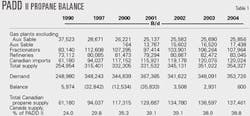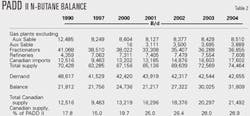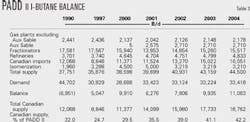Installation of the Aux Sable Liquid Products LP (Aux Sable) plant1 near the terminus of the Alliance pipeline (OGJ, July 2, 2001, p. 48) south of Chicago was a significant change from Alberta operators' traditional practice of locating a straddle plant in the producing region.
The Aux Sable plant has on site fractionation and also processes gas from the Western Canadian sedimentary basin (WCSB).
All other Alberta straddle plants are located in a producing region. The Edmonton straddle plant is near the Edmonton city gate but close to gas-producing fields.
Except for the Conoco Canada Midstream (CCM) Empress straddle plant, all other Alberta straddle plants recover a propane plus mix that they send to central fractionation in Alberta or Ontario.
Unlike other Alberta straddle plants, the CCM Empress plant has on site fractionation and supplies propane to local markets in Alberta, Saskatchewan, and Manitoba.
This article will discuss the disposition of NGL from the CCM Empress and Aux Sable plants and the impact of these NGL supplies on the local market.
Part 1 of this four-part series provided an historical perspective on Alberta straddle plants; Part 2 focused on the outlook for Alberta straddle plants.
NGL recovery, CCM Empress
In 2001, the CCM Empress plant recovered an estimated 11,500 b/d of propane.1 The plant also recovered: ethane 22,750 b/d, butanes 4,300 b/d, and pentanes plus (C5+) 2,130 b/d.
The CCM Empress plant has the McNeil terminal, which has truck and rail loading. There is also an NBL pipeline from Empress to Fort Whyte, near Winnipeg, Man. The NGL pipeline has terminals at Stewart Valley, Sask., Richardson, Sask., Rapid City, Man., and Fort Whyte, Man.
The local propane market in Southeast Alberta, Saskatchewan, and Manitoba is approximately 10,000 b/d; however, the propane market in Western Canada is seasonal.
In addition to on site surface storage, the CCM Empress plant has pipeline access to underground storage at Richardson and Regina. CCM owns the pipeline and underground storage; this control is an important factor in sustaining the viability of the combined system.
Propane exports via rail or truck from Manitoba can vary up to 10,000 b/d. Saskatchewan refineries only produce an estimated 1,300 b/d.2 CCM is, therefore, the largest propane supplier in Southeast Alberta, Saskatchewan, and Manitoba.
The CCM Empress plant provides C5+ as a heavy-oil diluent to local markets. The CCM Empress plant also has a butane splitter that supplies high-purity butanes to domestic and export markets. All of the CCM Empress ethane is sold to Alberta petrochemical plants.
NGL recovery, Aux Sable
The supply of NGL from Illinois increased dramatically in December 2000 when the Alliance pipeline and Aux Sable straddle plant started up.
The Aux Sable facility, at Channahon approximately 50 miles south of Chicago, is now one of the largest gas plants in North America. It can process up to 2.1 bcfd of natural gas delivered by Alliance and can recover approximately 70,000 b/d of NGL including ethane, propane, isobutane, n-butane, and natural gasoline.
Aux Sable's NGL recovery has al-tered traditional logistical patterns. Aux Sable supply has dramatically shifted Illinois from a propane deficit to a surplus.2
Aux Sable butane supply reduces imports during the winter and increases the need for summer exchanges to move excess product to seasonal storage.
Alliance and Aux Sable also altered the dominant position of the Empress straddle plants. Alliance and Aux Sable offer a competitive alternative to gas pipelines leaving the WCSB and NGL exports from Canada.
Aux Sable has pipeline connections to Equistar Chemical LP's Morris, Ill., ethylene plant and with nearby NGL pipelines; however, Aux Sable has no ownership in these pipelines or the connected underground storage facilities.
Unlike the CCM system in Western Canada, the Aux Sable plant—and the pipeline and storage infrastructure to which it is connected—cannot operate as an integrated system.
Illinois market
Fig. 1 shows Illinois propane supply and demand.2 During 1990-92, Illinois had a slight imbalance. From 1993 to 2000, annual Illinois propane demand exceeded supply. In 2000, the Illinois shortfall was 5,585 b/d.
Aux Sable propane recovery has transformed the Illinois annual propane deficit into a surplus. The Aux Sable propane supply helps meet the winter demand and adds to the summer surplus.
Aux Sable has exchange agreements to move most of its summer season propane and butane to the US Gulf Coast.
After Aux Sable started up, the average annual propane surplus in Illinois was an estimated 9,939 b/d in 2001.
Fig. 2 shows the monthly pattern of Illinois refinery propane supply and demand. It assumes that refinery propane supply is flat. In 2001, Illinois refinery propane supply was an estimated 25,000 b/d.
Fig. 2 also shows that propane demand in Illinois may fall to less than 20,000 b/d in the summer, which is why Aux Sable required the exchange agreements.
Illinois has no reported refinery isobutane supply,1 2 which means that all the isobutane produced in Illinois refineries is used internally.
Aux Sable recovers approximately 2,700 b/d of isobutane,2 most of which goes to refineries in Illinois or nearby states. Estimated Illinois de-mand for isobutane as an alkylation feedstock was 8,725 b/d in 2001.2
There is the potential for more use of isobutane in Illinois as refinery economics and octane requirements warrant. There is also some industrial demand for isobutane in Illinois as an industrial gas.
Refinery supply of normal and mixed butanes2 increased to an estimated 4,060 b/d in 2000 from 1,240 b/d in 1990. Aux Sable will supply approximately 3,500 b/d of n-butane, increasing Illinois n-butane supply to approximately 7,700 b/d in 2002.
Because the gasoline-blending requirement for n-butane is seasonal, Illinois should have a net external requirement for n-butane in the winter and significant summer surpluses.
A maleic anhydride plant in Joliet, Ill., consumes n-butane and there is also some industrial demand in Illinois. Aux Sable has exchange agreements to move n-butane to the US Gulf Coast in the summer.
The Aux Sable C5+ stream moves via rail back to Edmonton2 where it is used as diluent for heavy oil and bitumen (OGJ, Oct. 28, 2002, p. 64). Aux Sable can recover 35,000-40,000 b/d of ethane; with additional investment and an outlet market the Aux Sable plant could increase ethane recovery.
PADD II market
Table 1 shows that the Aux Sable propane supply in Petroleum Administration for Defense District (PADD) II has increased and shifted the balance from a deficit in 2000 to a projected surplus for 2002-04.
Table 1 also shows that total PADD II propane supply from Canada has increased to 35% in 2000, and 39% in 2001 with the start-up of Aux Sable, from 24% in 1990.
Table 2 shows that the Aux Sable n-butane supply in PADD II has increased and the surplus in 2002 was more than 2,500 b/d compared to 2000.
Table 2 also shows that the total PADD II n-butane supply from Canada has increased to 20% in 2000, and 25% in 2001 with the start-up of Aux Sable, from 15% in 1997.
Table 3 shows that the PADD II Aux Sable isobutane supply in 2002 increased more than 2,500 b/d compared to 2000.
Table 3 also shows that the total PADD-II isobutane supply sourced
from Canada has increased to 30% in 2000, and 36% in 2001 with the start-up of Aux Sable, from 25% in 1997.
The butane surplus in PADD II helps explain why Midcontinent fractionators and pipeline systems could not offer a competitive fractionation service or exchange agreement to Aux Sable.
Data in Tables 1-3 are average annu-al numbers and exclude inventory changes; therefore the monthly volumes could vary considerably.
The supply data in Tables 1-3 include domestic supply in PADD II including Aux Sable and propane and butane imports from Canada.
The calculations implicit in Tables 1-3 exclude any exchanges by Aux Sable or other parties with the US Gulf Coast.
Aux Sable outlook
Although the Alliance pipeline has favorable economics for expansion, it is unlikely until new gas supplies become available from the frontier areas.
There are plans to connect gas production from the Alaska North Slope (ANS) to the gas markets in the Lower 48 states. There are various options to process the ANS gas in Alaska, Alberta straddle plants, or elsewhere.3
Alliance was designed and built based on the concept of moving a high-btu gas to the Chicago market.
Part 2 discussed one advantage of the Alliance pipeline and Aux Sable plant; the Alliance connections with existing pipelines in the Chicago area require a lower gas pressure.
The pressure drop at Joliet will occur anyway; therefore Aux Sable does not have to recompress any gas sent to the Alliance pipeline.
If ANS gas moves through Alberta in a high-pressure line, the economics and market considerations may favor keeping NGL in the gas until it reaches a US market center with underground storage, pipeline, and market access.
In Alaska, butane and natural gasoline blended into ANS crude oil during 2000 were 41,000 b/d and 55,000 b/d, respectively.1
The NGL constituents of ANS gas flowing to the Lower 48 are primarily ethane and propane. Propane in the ANS gas may exceed 100,000 b/d, and ethane could exceed 200,000 b/d.
The Alliance Pipeline and Aux Sable plant can be expanded; however, the lack of control and the need to expand the connecting NGL infrastructure will be a roadblock to any Alliance effort to offer a competitive service for moving ANS gas into the market and an Aux Sable offer to process the ANS gas.
References
- "NGL Supply Yearbook 2002," PentaSul Inc., Houston.
- "LPG Outlook 2002," Hawkins Gas Consultants, multiclient study, July 2002.
- Hawkins, David J., "South From Alaska," 1075news, Propane Gas Association of Canada, Calgary, September-October 2001, p. 22.






